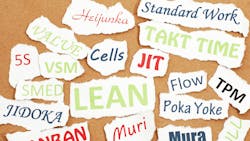Lean 101: Making Sense of Standardization
Key Highlights
- On the face of it, standardization and improvement may be viewed as extreme opposites.
- We look at the benefits of standardization.
- Some standardization benefits are specific to lean.
- Breaking down processes helps improve processes.
- Standardization doesn't mean "unchanging." Updating the standards is key.
Standardized processes are a critical requirement of a lean culture of continuous improvement. Employees who are new to lean are often puzzled by this, since standardization suggests a rigid, unwavering “cast-in-stone” type of process. This doesn’t appear to mesh well with a lean culture of continuous change and improvement.
Standardization and improvement may even be viewed as extreme opposites. This paradox must be resolved to provide clarity on lean.
Let’s begin to unravel this paradox and provide more clarity. For these reasons, companies need to develop and follow standardized processes, regardless of their production methodology.
1. To reduce variability. Whether your plan is to improve the process or not, you’ll still always want a consistent process for everyone to follow to produce a consistent outcome; i.e., a quality product or service on time for the customer.
2. To identify correct versus incorrect. Without a standard, there is no means for comparison. “Correct” has not been defined, so “incorrect,” or a deviation from a standard, cannot be determined. Problems with the current process remain hidden.
3. To enable effective training. Without a standardized process, how can you train someone in a manner that will produce the consistent outcome that you desire? How do you even choose which of the processing variations to train to?
Some benefits of standardization are specific to a lean culture of continuous improvement. Here are three reasons why standardized processes are essential in a lean organization.
1. To have a baseline to improve from. To improve and to measure progress, you must produce a gain from an initial starting point. You need a baseline. Without a standard process, this basic requirement of improvement is missing.
2. To have a single process to focus on. Without a standard—with everyone individually improving their own version of the process—you add even more variations, amplifying the chaos. Predictability is impossible due to the multitude of processing approaches. The resulting variations in time and quality will have negative performance ramifications—obviously not our intent.
3. To have the details necessary to enable improvement. To understand this benefit, we need to consider the process of developing standardization. The typical approach is to break the process down into manageable steps or actions, to make it easier to learn the process and perform it consistently. And then assign details to each step, such as timing and labor requirements that cover who does what and when, how long each step should take and what the expected outcome is.
Breaking down the process enables us to improve the process. It gives sufficient visibility to see where and what to improve—which parts of the process are causing quality issues, taking the most time or adding the most variability. And to examine why the process is needed, where it can best be done, by whom and whether there’s a better way.
When the potential improvement areas become evident, you almost can’t help but start asking questions: Why is this process needed? Where can it best be done and by whom? Is there a better way?
Updating the Standards Is Key
After each improvement, it is critical to update the standardized work and associated documents to prevent backsliding. Standardization locks in the improvement, and the new standardized process becomes the next target for improvement.
Without a new target, the cycle of improvement would either come to a grinding halt or a continual loop of improvement followed by backsliding would result. Progress would not be made. So, if there is no standardization, there is no ongoing improvement. As Taiichi Ohno, who many consider the father of lean, is attributed as saying, “Without standards, there can be no kaizen.”
This is a difficult concept for our minds to grasp—that standardization encourages change that leads to continuous improvement.
If we don’t understand the need for standardization, it is doubtful that we will develop the discipline and rigor needed to ensure that we continually develop, apply, analyze, improve and update standardized processes. This would slow or halt our improvement efforts, and the variability and chaos would return.
So, spend the time necessary to make sure there is clarity on this critical topic. In a lean organization, standardization is not the opposite of continuous improvement nor a hinderance. It is the foundation and catalyst for continuous improvement.
About the Author
David Rizzardo
Associate Director, Maryland World Class Consortia
Dave Rizzardo is the associate director of the Maryland World Class Consortia. His lean experience predates the time when lean became synonymous with business excellence. Dave co-developed the Lean Peer Group service, which helps organizations develop a lean culture. He currently facilitates multiple groups and works directly with organizations in helping them on their lean journeys. His book, Lean - Let's Get It Right! How to Build a Culture of Continuous Improvement, addresses the root causes of why many lean transformations fail to meet expectations, and he provides the information needed to turn things around.
